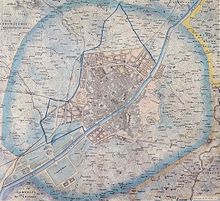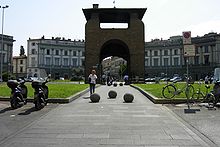Viali di Circonvallazione
The construction of the Viali di Circonvallazione (approximately bypass avenues ) was an urban development project in Florence in the 19th century. A series of avenues and squares was created that surround the historic city center north of the Arno . The work was part of a large-scale urban redevelopment called Risanamento (healing) under the leadership of the architect and town planner Giuseppe Poggi .
history
In 1864, Florence replaced Turin as the capital of the newly formed Kingdom of Italy during the Risorgimento . This required a redesign and modernization of the city center, which also meant the razing of the medieval city walls . In their place, as in many other major European cities at the time, a green ring road with representative squares was laid out based on the model of the Vienna Ringstrasse or the Parisian Grands Boulevards .
However, the representative aspect was not the only focus here. The increasing traffic and the growth of the city also required a restructuring of the road network. The location of the city between two mountain ranges in the north and south made the previous development even more difficult. The Viali di Circonvallazione meant an east-west connection to the exclusion of the historic city center with its narrow streets and, due to their course, represent the main inner-city traffic artery. From 1879 tram line 19 also ran along the Viali di Circonvallazione. The historic network was shut down in 1958.
course
Starting in the west at the Ponte alle Vittoria, the Viali di Circonvallazione is composed as follows:
- Piazza Vittorio Veneto with a central equestrian statue of King Victor Emanuel II. In favor of the new tram line 1, the street has been running through an underpass since 2003 . An underground car park has been planned for a long time.
- Piazzale di Porta al Prato
- Viale Fratelli Rosselli with the Torre della Serpe (Snake Tower). She crosses under the tracks to the Stazione Leopolda .
- Viale Filippo Strozzi also leads through an underpass at the level of Fortezza da Basso
- Viale Spartaco Lavagnini
- Piazza della Libertà with the Arco di Trionfo dei Lorena and the Porta San Gallo . From here Via del Ponte Rosso and Via Don Giovanni Minzoni branch off to the north.
- Viale Giacomo Matteotti
- Piazzale Donatello with the English cemetery on the central island
- Viale Antonio Gramsci
- Piazza Cesare Beccaria with the central Porta alla Croce and the headquarters of the daily newspaper La Nazione .
- Here the avenue divides into:
- Viale Giovine Italia with the Torre della Zecca
- Viale Giovanni Amendola .
This is where the Viali di Circonvallazione ends at the Ponte San Niccolò and on the other bank merges into the Viale dei Colli , also planned by Poggi , at the climax of which is the Piazzale Michelangelo .
Individual evidence
- ↑ Firenze: Sottopasso PIiazzale Vittorio Veneto, La Commissione Urbanistica appropva la realisazione finale. Città Metropolitana di Firenze, April 7, 2003, accessed December 9, 2015 .
- ↑ Ponte alla Vittoria, il parcheggio fantasma (forse) diventa realtà dopo dieci anni. July 4, 2011, accessed December 9, 2015 .


